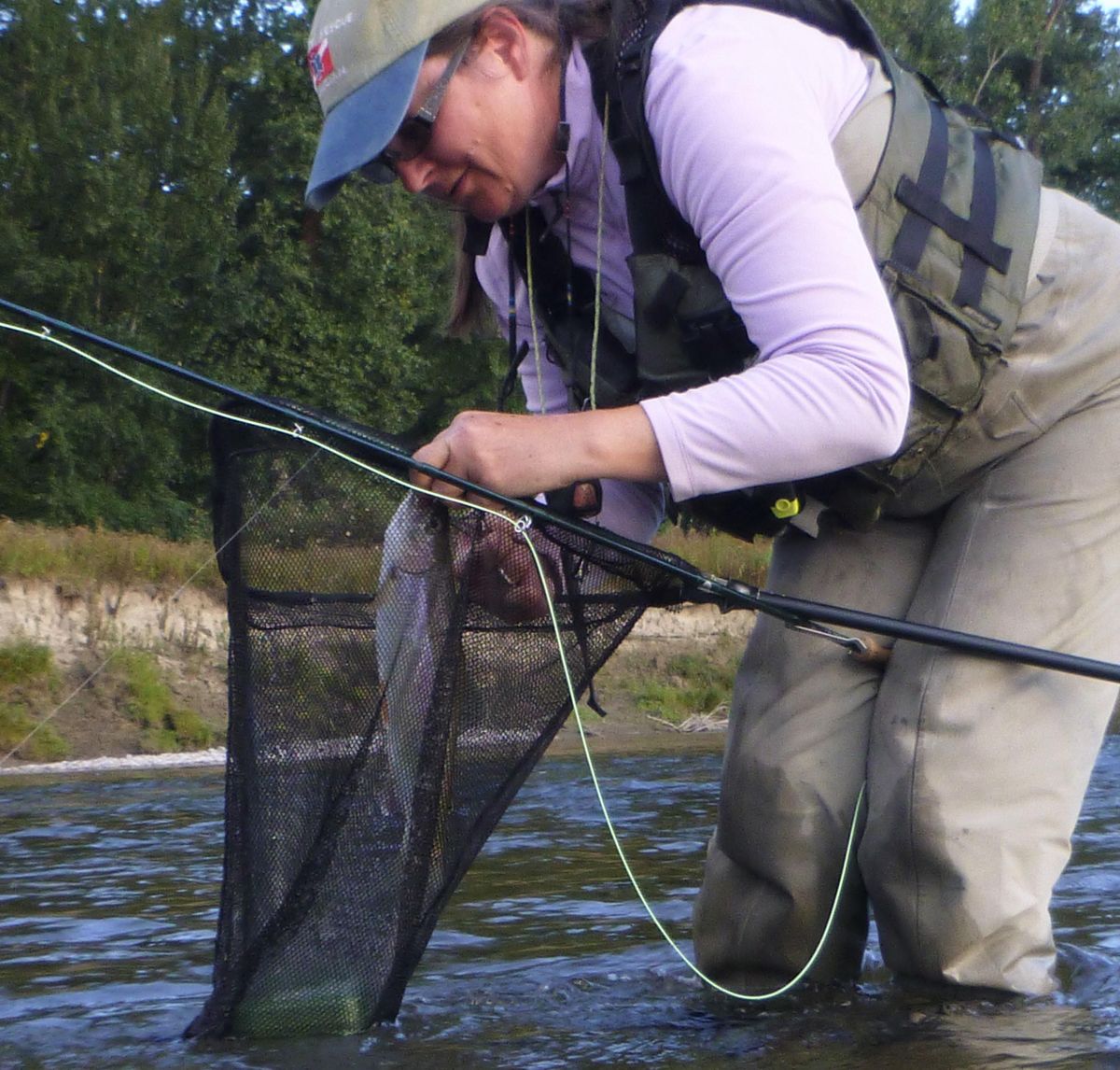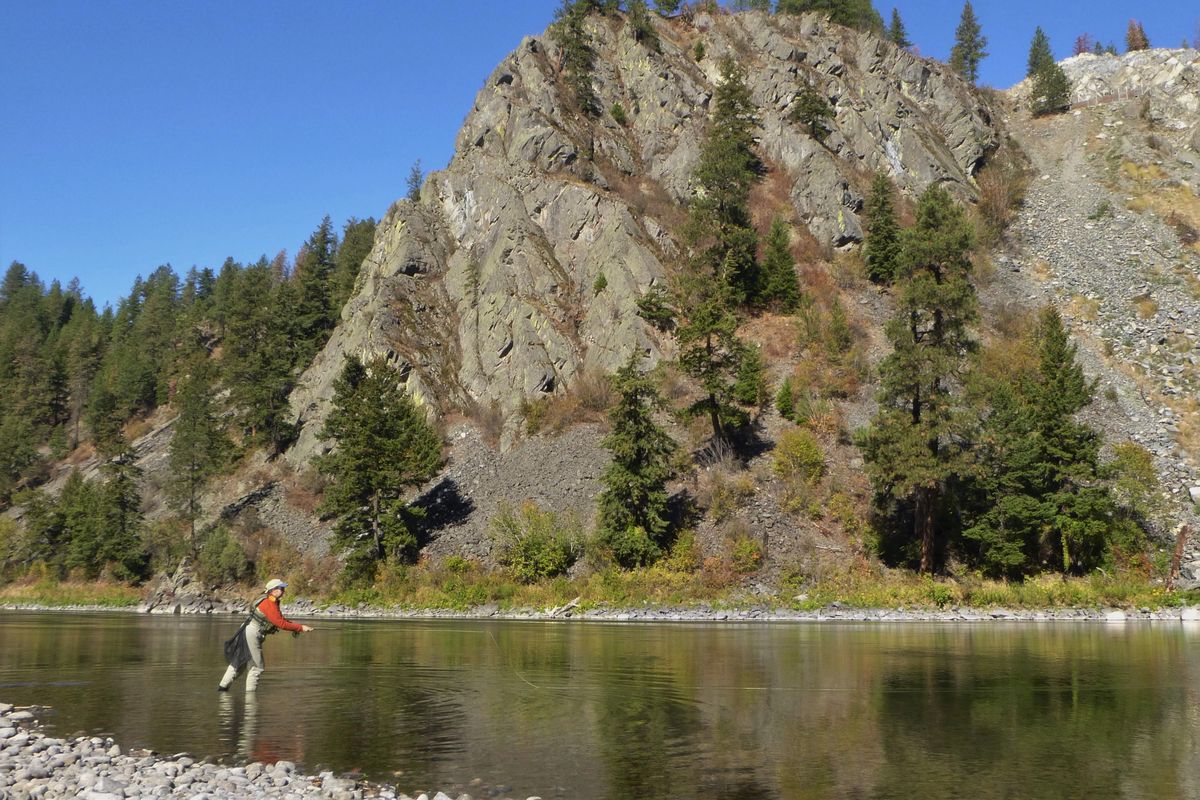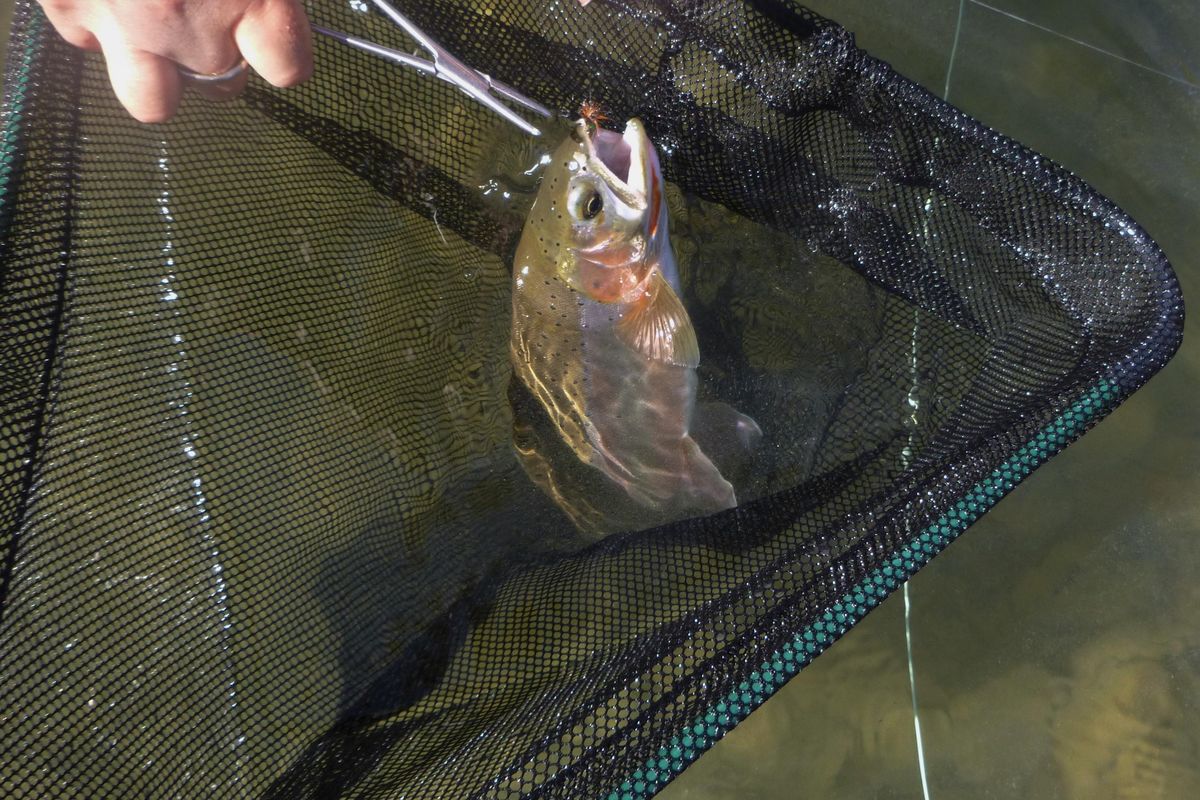Kootenai River improvements put shine on fall fishing
Fly fishers can find plenty of elbow room on the Kootenai River during fall. (Rich Landers / The Spokesman-Review)Buy a print of this photo
With schools rolling into high gear along with sports, hunting and salmon seasons, September is a prime month to go trout fishing, especially on the Kootenai River.
On Sunday, I floated a 7-mile North Idaho section east of Bonners Ferry without seeing another angler, save for my fly fishing partner, Leeanna Young.
Only the great blue herons, ospreys and bald eagles offered competition for catching the cutthroats, mountain whitefish and acrobatic red-band rainbows and cuttbows.
Elbow room like that was harder to find during summer.
The Kootenai from the Yaak River area in Montana downstream to Bonners Ferry has been catching increased attention in the past three years owing to improved river access and fisheries enhancement projects.
Idaho Fish and Game Department and the Kootenai Tribe of Idaho have been partnering in multimillion-dollar projects funded by the Bonneville Power Administration to boost fisheries that have been suffering the impacts of Libby Dam since 1972.
One problem is the quality of the water released from the impoundment. It’s cool and clear but also relatively devoid of nutrients needed to nourish the food chain.
Since 2005, a program to add nutrients to the water near the Idaho-Montana border has been gradually boosting growth of algae needed by aquatic insects.
The abundance of macro-invertebrates like caddisflies and mayflies has increased about five-fold, Kootenai Tribe biologists say.
The $50,000-per-year effort has improved the size and numbers of fish, from bottomfeeding suckers to rising rainbows, says Ryan Hardy, Idaho Fish and Game Department biologist.
The fishery upstream into Montana is benefiting from the Idaho nutrient program, he said.
Another problem is the flow regime that, among other things, has washed away fisheries habitat.
A major 10- to 15-year project started in 2011 to improve in-stream habitat for trout, sturgeon, burbot and other fisheries is restoring natural structure and checking erosion to boost fish and fishing.
My rod hand gets ready to set the hook every time my chosen fly pattern drifts past one of the root wads heavy equipment has planted along the stream.
Catch-and-release a large trout in a spot on one trip and you have a chance to hook the same fish in the same area on the next trip.
“Once established in the river, these Kootenai trout have very small home ranges,” Hardy said based on research. “They don’t go far.”
Sue Ireland, the Kootenai tribe’s fisheries director, said each of the projects along the river are carefully designed to accomplish certain things, such as guiding flow direction or reducing bank erosion.
Some features create pools intended to encourage sturgeon migration and provide winter hangouts for resident fish.
Still other projects improve the food web and provide security for juvenile fish.
“We’re proud of the designs and how the projects we’ve built so far have held up to really large fluctuations in runoff and the hydrology of a dynamic system,” she said.
Three years ago, just as the nutrient and habitat programs were showing significant improvements in the fishery, a new river access was established at Leonia just east of the Idaho-Montana border off U.S. 2.
The access provides more practical float-fishing options to long stretches of the river canyon that otherwise are off-limits to most anglers. Road access to the Kootenai from Montana to Bonners Ferry is extremely limited and most of the land along its shores is private.
“That access has made a huge difference in our rafting and shuttle business,” said Rex Hoisington of Twin Rivers Canyon Resort near Moyie Springs. The resort and campground, which is open through Oct. 31, offers floater shuttles for $40.
The Leonia access was opened in 2013 on a trial basis. Users were responsible and did not trash the place, so the landowner has agreed to extend the lease, Hardy said.
The access gives floaters an option to start in Montana near the Yaak River and float 5 miles to Leonia.
The access also means Idaho anglers don‘t have to float the Montana stretch to reach Idaho’s section of the river.
Trout anglers prefer the floats from Leonia 12 miles downstream to Twin Rivers (at the confluence with the Moyie River) as well as from the resort 7 miles to the Bonners Ferry take-out downstream from the U.S. 95 bridge.
Float-fishers have excellent catch rates of roughly one fish per hour, Hardy said. “Anglers tell our creel surveys they are very satisfied with the catch rates and size of fish they are seeing.”
Most of the trout anglers are catching in the Kootenai project area are 8-14 inches long, but 16 inchers are not uncommon and the occasional bigger trout is caught.
Unlike the St. Joe and Coeur d’Alene rivers’ catch-and-release cutthroat fisheries, Idaho allows anglers to harvest large trout in the Kootenai. The daily limit is two trout, with a minimum size of 16 inches for rainbows and cutthroats.
The best catch rates are in June and July, Hardy said.
September and October have other factors to consider.
The flows, which were holding at 9,000 cfs three months ago, have been in the neighborhood of 7,000 cfs for two months. This concentrates fish, but also poses some challenge in choosing the best routes through the braided river sections.
Fewer bugs are hatching to bring trout to the surface than during summer. Hoppers are absent and October caddis weren’t showing. But the fish have a memory for the hopper heydays, so those patterns are always worth a try, maybe with a dropper.
Fish are feeding actively one way or another as they sense winter coming on. They can fall for attractor patterns even when no bugs are in sight. We caught trout and whitefish on Sunday on dry flies, as well as soft-hackle imitations and nymphs.
The crisp, clear air and fall colors that were emerging in the canyon were a bonus.
And the solitude was priceless.




